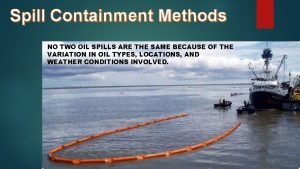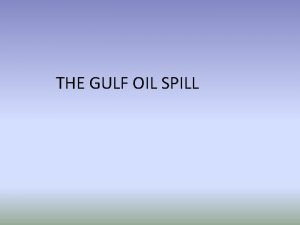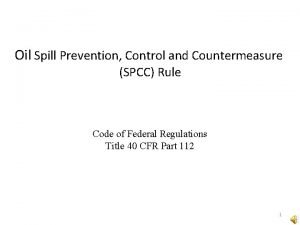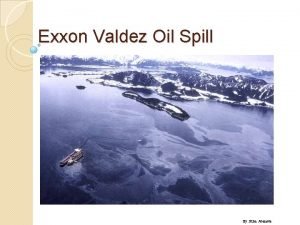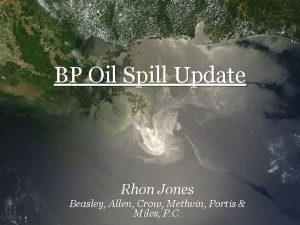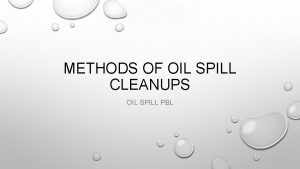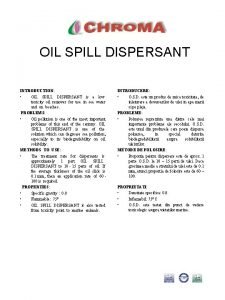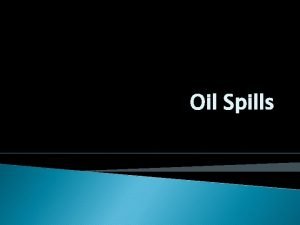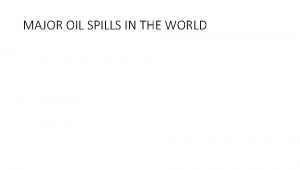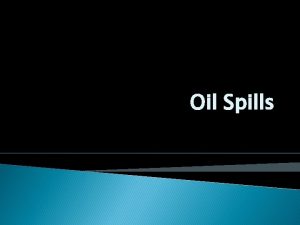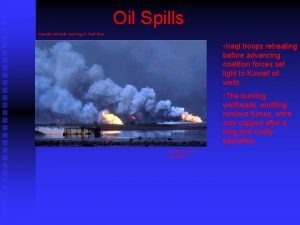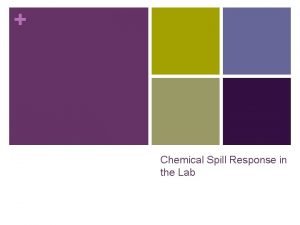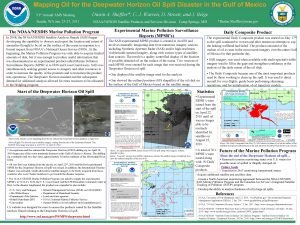Spill Containment Methods NO TWO OIL SPILLS ARE











- Slides: 11

Spill Containment Methods NO TWO OIL SPILLS ARE THE SAME BECAUSE OF THE VARIATION IN OIL TYPES, LOCATIONS, AND WEATHER CONDITIONS INVOLVED.

During a spill response, sensitive locations threatened by an advancing oil slick can be protected with various kinds of equipment and tactics.

Booms are floating, physical barriers to oil, made of plastic, metal, or other materials, which slow the spread of oil and keep it contained. Skilled teams deploy booms using mooring systems, such as anchors and lines. They commonly place boom: Across a narrow entrance to the ocean, such as a stream outlet or small inlet, to close off that entrance so that oil can't pass through into marshland or other sensitive habitat. In places where the boom can deflect oil away from sensitive locations, such as shellfish beds or beaches used by piping plovers as nesting habitat. Around a sensitive site, to prevent oil from reaching it.

There are three main types of boom: Hard boom Sorbent boom Fire boom

Hard boom is like a floating piece of plastic that has a cylindrical float at the top and is weighted at the bottom so that it has a "skirt" under the water. If the currents or winds are not too strong, booms can also be used to make the oil go in a different direction (this is called "deflection booming").

SORBENT BOOM LOOKS LIKE A LONG SAUSAGE MADE OUT OF A MATERIAL THAT ABSORBS OIL. IF YOU WERE TO TAKE THE INSIDE OF A DISPOSABLE DIAPER OUT AND ROLL IT INTO STRIPS, IT WOULD ACT MUCH LIKE A SORBENT BOOMS DON'T HAVE THE "SKIRT" THAT HARD BOOMS HAVE, SO THEY CAN'T CONTAIN OIL FOR VERY LONG.

Fire boom is not used very much. It looks like metal plates with a floating metal cylinder at the top and thin metal plates that make the "skirt" in the water. This type of boom is made to contain oil long enough that it can be lit on fire and burned up.

Skimmers are boats and other devices that can remove oil from the sea surface before it reaches sensitive areas along a coastline. In the photo below, oil is being skimmed from the sea surface by a "vessel of opportunity. " Sometimes, two boats will tow a collection boom, allowing oil to concentrate within the boom, where it is then picked up by a skimmer.

Other Ways: Burning In-situ: In simple terms, this means burning of the oil on the site where the spillage has occurred. The burning has to be done quite promptly before the oil spill can spread to a larger area. But the most important disadvantage of such an on-site burning is that the exhaust that is released contains toxic particles that can cause damage to the oceanic air in addition to the marine life-forms Using Hot water and huge force: In this method, huge force of the hot water is used to push the oil spilt back into the water. Then with the help of the skimming tools and equipments, the oil spill cleanup operation takes place. Using Manual labour: People in the coastal areas and beaches can help to accelerate the oil spill cleanupoperation. By using simple tools like spades and shovels, removing and isolating the area affected by oil spillage is possible. Using Technological aid: By using cranes and tractors, the oil spillage area in beaches and coastal areas can be cleaned. If it is not possible to carry out the oil spill cleanup operation, there itself they can be taken to labs and other equipped areas where the oil spill can be separated from the sand other items generally found in the beaches and coastal areas.

Using natural methods: The simplest method of dealing with the oil spill cleanup operation is to make use of the components of nature like the sun, the wind, the weather and the tides. The particles of the oil spill, in due course of time evaporate because of the constancy of these elements. This also forms the most cost efficient and the slowest method of cleaning up oil spills. With the help of these methods of oil spill cleanup, the task and its hugeness do not affect the optimism of the person. Just like one makes use of the broom, these methods are adopted to clean affected and problematic areas at a much higher level. However it can be hoped that since many shipping companies are getting aware of the risks and problems caused to the oceanic atmosphere, the requirement of such oil spill cleanup methods will reduce in the days to come.

